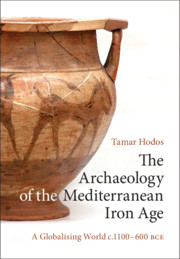Book contents
- The Archaeology of the Mediterranean Iron Age
- The Archaeology of the Mediterranean Iron Age
- Copyright page
- Dedication
- Contents
- Illustrations
- Preface
- Acknowledgements
- One Interpreting the Mediterranean
- Two Chronologies and Histories
- Three The Movement of People
- Four Contacts and Exchanges
- Five Urbanisation
- Six Written Words
- Seven Conclusions
- Notes
- References
- Index
Four - Contacts and Exchanges
Published online by Cambridge University Press: 12 September 2020
- The Archaeology of the Mediterranean Iron Age
- The Archaeology of the Mediterranean Iron Age
- Copyright page
- Dedication
- Contents
- Illustrations
- Preface
- Acknowledgements
- One Interpreting the Mediterranean
- Two Chronologies and Histories
- Three The Movement of People
- Four Contacts and Exchanges
- Five Urbanisation
- Six Written Words
- Seven Conclusions
- Notes
- References
- Index
Summary
To understand the nature of interconnections between people in dispersed places, we must first consider by what means such groups maintain those connections. This is what underpins globalisation processes in a globalising world. Indeed, in modern discourse, globalisation is often regarded initially and predominantly as of an economic nature, from which other forms of connectivity develop, including socio-cultural ones. The foundations of the intensive and widespread interconnectivities we see developing over the Mediterranean Iron Age have their origins in the exchange of objects. This is an economy of both things and ideas, however, since the use of objects in new contexts may well differ from how such items were used in their context of origin. Understanding both their common appeal and transnationalised uses together enables us to consider globalisation in action.
- Type
- Chapter
- Information
- The Archaeology of the Mediterranean Iron AgeA Globalising World c.1100–600 BCE, pp. 95 - 146Publisher: Cambridge University PressPrint publication year: 2020

